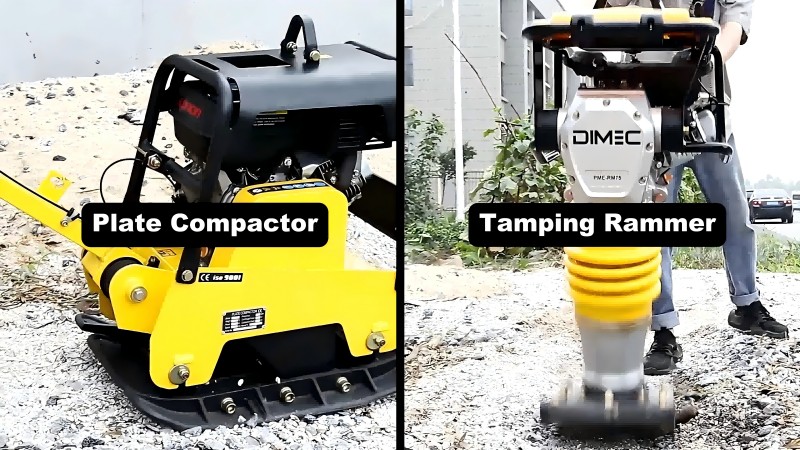Plate Compactor vs. Tamping Rammer: Which Compact Equipment Wins for Different Soil Types?
- DIMEC
- Plate Compactor, Tamping Rammer
Home » Plate Compactor vs. Tamping Rammer: Which Compact Equipment Wins for Different Soil Types?

Table of Contents
1. Introduction
Compaction is a critical step in any construction project, ensuring soil stability and strength. Choosing the right equipment—whether a plate compactor or a tamping rammer—depends largely on the soil type and project requirements. Understanding the differences can help optimize efficiency and cost-effectiveness in construction.
2. What Is a Plate Compactor?
A plate compactor is a vibratory machine that uses a heavy plate to exert downward force on the soil, making it ideal for compacting granular materials like sand and gravel. It operates by generating high-frequency vibrations, which help particles settle more tightly.
Key Applications
Roadwork and pavement compaction
Compacting sand and gravel for landscaping
Preparing sub-bases for driveways and sidewalks
3. What Is a Tamping Rammer?
A tamping rammer, often called a jumping jack, is a high-impact machine that delivers concentrated force to compact soil. Unlike plate compactors, it moves in an up-and-down motion, making it effective for compacting cohesive soils like clay.
Key Applications
Trench compaction
Working in confined spaces
Compacting heavy clay and silt
4. Key Differences Between Plate Compactors and Tamping Rammers
| Feature | Plate Compactor | Tamping Rammer |
| Motion | Vibratory | Up-and-down impact |
| Best for | Granular soils | Cohesive soils |
| Coverage Area | Large | Small |
| Ease of Use | Easier | Requires skill |
| Depth of Compaction | Shallow | Deep |
5. Understanding Soil Types in Construction
Soil types significantly impact compaction effectiveness:
Granular soils (sand, gravel) are best compacted with vibration.
Cohesive soils (clay, silt) require impact force for effective compaction.
6. Best Soil Types for Plate Compactors
Dry sand and gravel
Crushed rock mixtures
Sub-base materials for roads and patios
7. Best Soil Types for Tamping Rammers
Moist clay
Silt-heavy soil
Highly cohesive, sticky materials
8. Advantages of Using Plate Compactors
Covers large areas quickly
Provides even compaction
Requires less physical effort
9. Advantages of Using Tamping Rammers
Compacts deep layers effectively
Ideal for confined spaces
Works well in wet conditions
10. Limitations of Each Equipment Type
Plate compactors struggle with wet clay.
Tamping rammers are less effective on dry, granular soil.
11. Choosing the Right Equipment for Your Project
Consider:
Soil type: Granular (plate compactor) vs. cohesive (rammer)
Project size: Large areas (plate) vs. trenches (rammer)
Cost and availability
12. Cost Comparison: Plate Compactor vs. Tamping Rammer
Plate compactors: $500–$3,000
Tamping rammers: $1,500–$4,000
Operational costs: Rammers require more maintenance
13. Safety Measures When Using Compact Equipment
Wear protective gear (gloves, goggles, boots)
Operate on stable ground
Maintain proper footing
14. Maintenance Tips for Longevity
Clean after each use
Check fuel and oil levels regularly
Store in a dry area
15. Conclusion
Both plate compactors and tamping rammers serve crucial roles in construction. The best choice depends on soil type, project scope, and budget. Understanding their differences ensures optimal compaction and project success.
FAQs
1. Can I use a plate compactor on clay?
No, plate compactors work best on granular soils like sand and gravel. For clay, a tamping rammer is the better choice.
2. How deep can a tamping rammer compact soil?
Tamping rammers can compact soil up to 24 inches deep, depending on soil conditions and machine power.
3. Are plate compactors hard to operate?
No, plate compactors are user-friendly and require minimal effort, making them suitable for beginners.
4. What is the maintenance requirement for compact equipment?
Regular cleaning, oil checks, and storage in a dry place help prolong the lifespan of both plate compactors and tamping rammers.
5. Which equipment is more cost-effective?
Plate compactors generally have lower maintenance costs and last longer with proper care, making them more cost-effective for larger projects.
6. Can tamping rammers be used in small spaces?
Yes, tamping rammers are ideal for tight spaces like trenches and foundations where plate compactors cannot reach.
You May Also Like